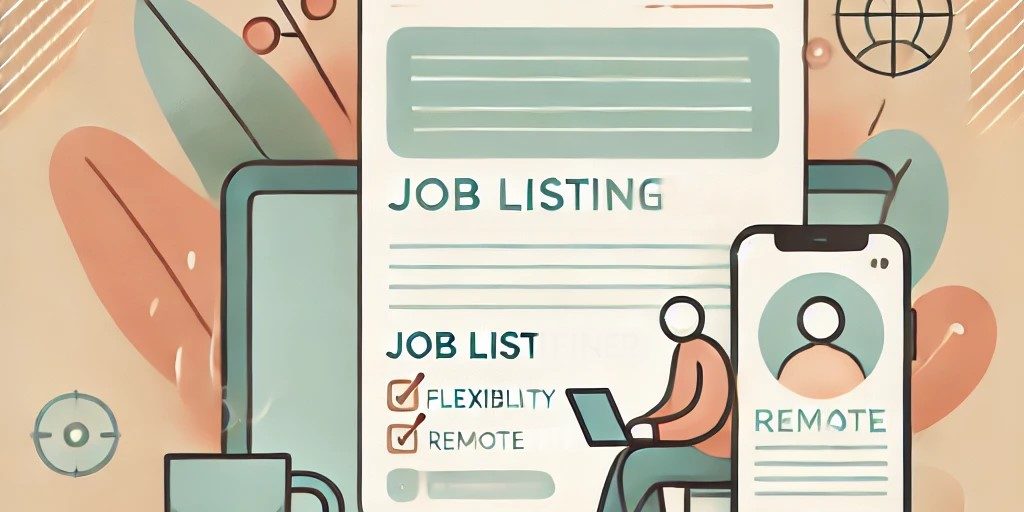Virtual hiring offers access to a global talent pool, unlocking a wealth of skills and perspectives that traditional methods simply can’t reach. To thrive, businesses must not only adopt virtual hiring but master it, ensuring they attract and secure the very best candidates, regardless of where they are located.
Crafting remote-first job descriptions to attract candidates
Your job description is often the first interaction a potential candidate has with your company. In the virtual hiring landscape, it’s even more critical to make a strong first impression. Think of it as your digital handshake. A generic, location-dependent job description simply won’t cut it. To attract top-tier remote talent, your job descriptions need to be explicitly remote-first and highlight the advantages of virtual work.
Elements of an attractive remote job description:
- Clearly state “remote” or “work-from-home”: be upfront and unambiguous in the job title and description. Examples: “Remote [Job Title]”, “[Job Title] – Remote Opportunity”, “Work-From-Home [Job Title]”.
- Highlight remote work benefits: go beyond salary and list tangible benefits of working remotely. Think about:
- Flexibility and work-life balance: “enjoy a flexible schedule and the ability to work from anywhere.”
- Location independence: “work from the comfort of your home, or your favourite coffee shop, anywhere in [Country/Region].”
- Reduced commute: “say goodbye to your commute and reclaim valuable time.”
- Autonomy and trust: “we are a results-oriented company that trusts our team to manage their time effectively.”
- Focus on outcomes, not just location: shift the focus from where work is done to what needs to be accomplished. Clearly define responsibilities and success metrics.
- Showcase company culture (virtually): convey your company culture, even in a remote context. Use language that reflects your values and how you foster connection and collaboration in a virtual environment. Mention virtual team-building activities or communication tools you use.
Example – making it attractive:
Instead of: “Marketing Manager – Warsaw Office”
Try this: “Remote Marketing Manager – Drive Impact from Anywhere” followed by description highlighting flexible hours, autonomy, and virtual collaboration opportunities.
By crafting job descriptions that are explicitly remote-friendly and benefit-driven, you immediately signal to top talent that you are a modern, forward-thinking organization that values flexibility and results.
Enhancing candidate experience in the virtual hiring process: key strategies
Candidate experience is paramount in any hiring process, but it takes on a new dimension in the virtual realm. Every interaction, from application to virtual interviews, must be carefully crafted to be positive, engaging, and efficient.
Improving the overall candidate experience:
- Clear and consistent communication: over-communicate. Provide timely updates at each stage of the process. Let candidates know what to expect and when. Silence is the enemy of a positive candidate experience.
- Example: instead of a generic “We’ll be in touch,” send an email after the initial application confirming receipt and outlining the next steps and expected timelines.
- Transparency is key: be transparent about the hiring process, timelines, and what candidates can expect at each stage. If there will be multiple interview rounds, let them know upfront.
- Streamlined application process: make it easy to apply. Mobile-friendly applications are a must. Avoid overly lengthy or cumbersome forms. Consider offering application options via LinkedIn or other professional platforms.
- Prompt and constructive feedback (even for rejection): respect candidates’ time by providing timely feedback, regardless of the outcome. Even a brief, personalized rejection message is far better than radio silence. Consider offering constructive feedback where possible (especially for later-stage candidates).
Leveraging technology for an enhanced experience:
Technology is the backbone of successful virtual hiring and a key enabler of a positive candidate experience.
- Applicant Tracking Systems (ATS): utilize an ATS to streamline applications, track candidate progress, and automate communication. Choose an ATS with a user-friendly interface for both recruiters and candidates.
- Video conferencing platforms: invest in reliable, high-quality video conferencing platforms for virtual interviews. Ensure they are easy to use and offer features like screen sharing and recording (with candidate consent).
- Scheduling tools: use scheduling tools to minimize back-and-forth emails and allow candidates to book interview slots that work for them.
- Communication platforms: consider using platforms for real-time communication and Q&A during the hiring process (if appropriate and communicated clearly to candidates).
Beyond general tools for communication and process management, specialized technologies like Focus Audit Tool can directly enhance the quality and objectivity of your virtual hiring process, particularly when verifying candidate language skills. In today’s globalized talent market, and especially for remote roles requiring specific language proficiencies, accurate language assessment is crucial.
- Standardize language skill assessments: use structured, digital assessments directly on the platform to evaluate candidate language proficiency consistently. This moves beyond subjective impressions from interviews and provides a more objective and comparable metric across candidates.
- Ensure objectivity and reduce bias in language evaluation: by using standardized assessment criteria and digital tools, you can minimize unconscious bias in language evaluation. Focus Audit Tool can help ensure all candidates are evaluated against the same language proficiency benchmarks, leading to fairer hiring decisions.
- Streamline language assessment for international candidates: for virtual hiring targeting international talent pools, efficient and reliable language verification is essential. Focus Audit Tool can help you manage and track language assessments for numerous international candidates, ensuring you efficiently identify those with the required language skills.
- Improve quality of hire for language-dependent roles: by implementing robust language verification using tools like Focus Audit Tool, you can significantly improve the quality of hire for roles where language skills are paramount. Ensure you are selecting candidates who not only claim to have the necessary language skills but can demonstrably prove them through a standardized and objective assessment.
By strategically incorporating technology like Focus Audit Tool for language skill verification, you add a layer of rigor and objectivity to your virtual hiring process, particularly vital when assessing international candidates or filling roles requiring specific linguistic capabilities. This ultimately leads to better hiring decisions and a stronger, more effectively communicative remote workforce.
Mastering the virtual interview experience
Virtual interviews are the cornerstone of virtual hiring. To ensure a positive candidate experience and accurate assessment, focus on these areas:
- Technical preparation: test your technology beforehand. Ensure your internet connection is stable, your camera and microphone are working, and your background is professional. Advise candidates to do the same.
- Platform familiarity: be proficient in using your chosen video conferencing platform. Guide candidates if they are unfamiliar with it. Offer a brief technical check-in before the actual interview.
- Engaging interview techniques: virtual interviews can feel less personal. Be extra mindful of maintaining eye contact (look at the camera!), using enthusiastic body language, and creating a conversational tone. Ask engaging questions and encourage candidate questions.
- Structured interviews: use structured interview questions to ensure fairness and consistency across all candidates.
- Minimize distractions: find a quiet, private space for your interviews, and minimize any potential interruptions.
- Clear next steps at the end: clearly communicate the next steps in the hiring process and expected timelines at the end of each interview.
Example – virtual interview do’s and don’ts:
Do: Send a calendar invite with the video link and any relevant information well in advance. Start the interview with a friendly chat to build rapport. Actively listen and ask follow-up questions.
Don’t: Be late to the interview. Have distracting backgrounds or noises. Multitask or appear disengaged. End the interview abruptly without clarifying next steps.
Maintaining engagement throughout the process
Candidate engagement shouldn’t stop after the application. Keeping candidates interested and informed throughout the often lengthy hiring process is crucial.
- Regular updates: provide periodic updates on their application status, even if there are no major changes. A simple “checking in, we’re still reviewing applications and will update you by [date]” email can go a long way.
- Content sharing: share relevant content about your company culture, values, or employee stories with candidates during the process. This helps them stay connected and reinforces their interest.
- Quick response times: aim for prompt responses to candidate inquiries. Slow responses can signal disinterest or disorganization.
- Personalized communication: whenever possible, personalize your communication. Refer to specific aspects of their application or interview in your follow-up messages.
Overcoming the challenges of virtual hiring
Virtual hiring, while powerful, isn’t without its challenges. Being aware of these potential hurdles and having strategies to overcome them is essential for success.
Challenge: building rapport and assessing culture fit virtually
Solution: utilize video interviews to their full potential. Incorporate behavioural interview questions, team introductions via video, and virtual “coffee chats” to assess cultural alignment. Showcase your company culture through videos and virtual tours.
Challenge: technical glitches and connectivity issues
Solution: have backup plans. Offer phone interview options if video fails. Provide clear instructions on platform usage and troubleshooting tips to candidates beforehand. Be patient and understanding if technical issues arise.
Challenge: maintaining candidate engagement in a remote setting
Solution: implement the engagement strategies mentioned earlier – regular updates, content sharing, personalized communication. Consider virtual “meet the team” sessions.
Challenge: onboarding new remote hires effectively
Solution: develop a structured virtual onboarding program. Utilize online learning platforms, provide clear documentation, and schedule regular check-ins with managers and mentors. Foster virtual team introductions and social connection opportunities.
Challenge: potential for miscommunication and lack of nonverbal cues
Solution: emphasize clear and concise communication in all interactions. Encourage the use of video for interviews and team meetings to enhance nonverbal communication. Be mindful of time zones and cultural communication differences.
Virtual hiring for international candidates: expanding your talent pool globally
Virtual hiring truly shines when it comes to accessing international talent. However, hiring across borders brings unique considerations:
- Compliance and legal matters: understand international labour laws, tax regulations, and visa requirements (if applicable). Consult with legal experts when necessary. Consider using Employer of Record (EOR) services to simplify international employment.
- Time zone differences: be mindful of time zones when scheduling interviews and meetings. Offer flexible interview times and be accommodating.
- Cultural differences: be aware of cultural nuances in communication styles, interview etiquette, and workplace norms. Train your hiring team on cross-cultural communication best practices.
- Communication strategies: establish clear communication channels and expectations, especially when dealing with different time zones and potential language barriers.
The power of feedback loops: continuous improvement in your remote hiring process
The journey of optimizing your virtual hiring process is ongoing. Implementing candidate feedback loops is essential for continuous improvement and ensures you are consistently refining the candidate experience.
- Post-interview surveys: send out short, anonymous surveys to candidates after each interview stage to gather feedback on their experience. Ask about clarity of communication, interview process efficiency, interviewer professionalism, etc.
- Feedback from hired (and non-hired) candidates: consider conducting brief feedback interviews with both successful and unsuccessful candidates to gain deeper insights into their experiences.
- Analyse feedback regularly: review feedback data to identify trends, pain points, and areas for improvement in your virtual hiring process.
- Implement changes and measure impact: based on feedback insights, implement changes to your process and track key metrics (candidate satisfaction, time-to-hire, offer acceptance rates) to measure the impact of your improvements.
Embracing virtual hiring for a successful future
Virtual hiring is no longer a niche strategy; it’s the future of talent acquisition. By embracing a thoughtful, technology-driven, and candidate-centric approach to virtual hiring, you can unlock access to a global talent pool, build a diverse and skilled workforce, and gain a significant competitive advantage. Investing in a positive virtual candidate experience is not just good practice; it’s a strategic imperative for attracting and securing the top talent your organization needs to thrive in the digital age. By continually refining your process through feedback and adaptation, you can ensure your virtual hiring strategy remains a powerful engine for growth and innovation for years to come.






